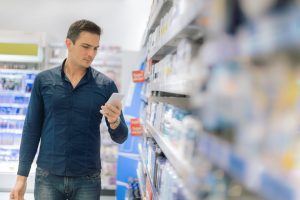3 steps to a successful integrated retail strategy
Aligning the in-store experience with online and mobile channels should be a priority for every retailer. We now see these different channels are not competing with one another, but rather that consumers are using all channels to serve their various needs. They want convenience, information, and instant gratification. If you’re not serving these needs seamlessly across all platforms, you’re losing market share to someone who can.
An integrated retail strategy assures customers that they can expect the same caliber of excellence from your brand at every turn. For example, integrated marketing allows you to deliver uniform messaging to the right shopper at the right time, building brand awareness when it matters most.
Why Integration Is Critical to a Successful Retail Strategy
Consider the many reasons to prioritize the development of retail integration:
Your customers expect it. At least 84% of consumers feel retailers should “do more” to integrate online and offline shopping channels. No retailer wants customers to feel disappointed or frustrated with the shopping experience, no matter where it may be. Just one bad shopping experience can cause a consumer to lose interest in a brand for good.
It will increase your bottom line. Retailers who have traditionally relied on brick-and-mortar stores for sales have been surprised by how much growth adding an online channel delivers. Walmart, for instance, saw sales increase by 30% after establishing an eCommerce site.
Mobile has become a popular channel. Analysts estimate more than half of all retail eCommerce will take place via mobile device by the end of 2021. Mobile lets you reach customers when and where they like to shop.
Integration drives loyalty. Companies with strong omnichannel retail strategies retain approximately 89% of their customers from channel to channel, compared to a 33% retention rate for businesses with weak integration.
Steps to Successfully Integrate Your Retail Strategy
Ready to integrate, but not sure where to start? These three steps will point you in the right direction.
1. Enhance Store Merchandising and Inventory
People love opportunities to interact with products in person and gain personalized assistance from store associates. However, they also like modern conveniences found online, such as in-depth product information, social reviews, digital displays, and ordering kiosks.
The last thing you want is for a customer to leave your store empty-handed and frustrated. Shoppers want to know what’s in stock before visiting your store. They want to put items into virtual shopping carts and pick them up in-store.
Advanced integration involves providing shoppers with:
Access to the latest inventory and out-of-stock items with ship-to-store
Expedited shopping trips and instant gratification with buy-online-pickup-in-store
Opportunities to select different colors and styles of in-store items online
Integration for physical gift cards and loyalty programs online and offline
Flexible information from in-store associates with real-time inventory data
What you need to complete this objective is a robust back-office and store-level platform that can help you improve your supply chain management. Microsoft Dynamics for Retail is one such tool you might consider. For instance, when a shopper at Ashley Furniture orders a dining room set, finish, and fabric, Microsoft Dynamics for Retail seamlessly drives the configuration through the supply chain back to the manufacturer, so delivery dates are accurate.
2. Use Actionable Data to Serve Customers Better
Today’s consumers are willing to share their personal details if it means they’ll receive more individualized service. At a minimum, you should be tracking the channels utilized, locations shopped, and demographics.
Take your analysis to the next level by installing an end-to-end retail platform that centralizes data from various sources. Look at individual parameters such as products purchased online and offline, products left in the shopping cart, website clicks, and content viewed. Advanced in-store beacon technology can track eye movements, the amount of time spent in-aisle considering a product, and other useful metrics linked to a person’s shopping behaviors through a mobile smartphone.
With each experience a customer has with your brand, you need to follow them wherever they go. If someone adds a product to their shopping cart online, it should appear in their mobile app shopping cart too. If they visit Facebook, you should run a custom ad of suggested products based on past purchases. When a customer in your store lingers in a particular aisle, you can send a relevant mobile coupon to convert the sale.
3. Make Mobile an Integral Part of Your Retail Experience
Mobile phones are not simply accessories for pockets and purses. They are vital resources that facilitate purchases. Deloitte estimates the use of mobile devices before or during in-store shopping trips helps convert over $593 billion dollars a year for U.S. businesses.
There are many ways to ramp up your mobile integration:
Consider how beauty brand Sephora connects their Beauty Insider program with a mobile app and Apple Passbook. Customers can view their loyalty card details to scan at the register, so they don’t have to carry a physical card in their wallets. They can look through their past purchases and wish lists and present them to sales associates for additional recommendations.
Neiman Marcus has an app that allows customers to view upcoming promotions and send their favorite products to a dressing room to await their arrival. Sales associates receive this information in real-time to respond. They can also view a shopper’s online and in-store purchase histories; access a list of items most frequently purchased along with a current item in the shopper’s dressing room; and receive a notification with photo ID when the customer enters the store.
Starbucks offered such great perks to their mobile app users that they saw the number of users increase from 2 to 4 million in one year’s time. They identified three key touchpoints for intervention. First, when a user checks the app to find a nearby location, the app directs them using mapping technology. Once they are waiting in line, the app sends push notifications with codes to access music and movies. To expedite check out, the mobile app serves as a way to pay as well.
Why reinvent the wheel when there are already proven methods to reach and engage consumers? Shopkick offers rewards points it calls “kicks” to app users who engage with their partner brands in-store and online. Shopkick seamlessly covers the full funnel purchase journey—at home on the couch, on the go, in-store, and through to purchase. Loyal Shopkickers watch branded in-app videos, scan items in-store, and make purchases that earn them kicks. VISA Decision Sciences measured the effectiveness of implementing a Shopkick retail campaign and found: 57% of sales driven by Shopkick were incremental; 73% of these incremental sales were new customers; and 27% of incremental purchases came from loyal customers to solidify brand affinity.
Shopkick seamlessly covers the full funnel purchase journey—at home on the couch, on the go, in-store, and through to purchase.
With the right tools, a successful integrated retail strategy is within your reach. Identifying where the seams between channels exist will help you improve on core efficiencies, meet consumer demands, and convert more customers into long-term loyalists.
Take the first step toward a successful integrated retail strategy. Read more of our partners success stories and contact Shopkick to learn how to make mobile a more prominent part of your omnichannel marketing plan.



